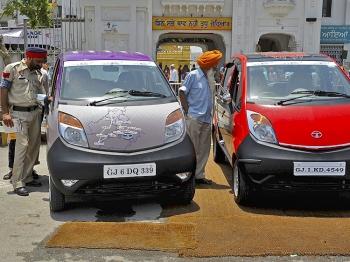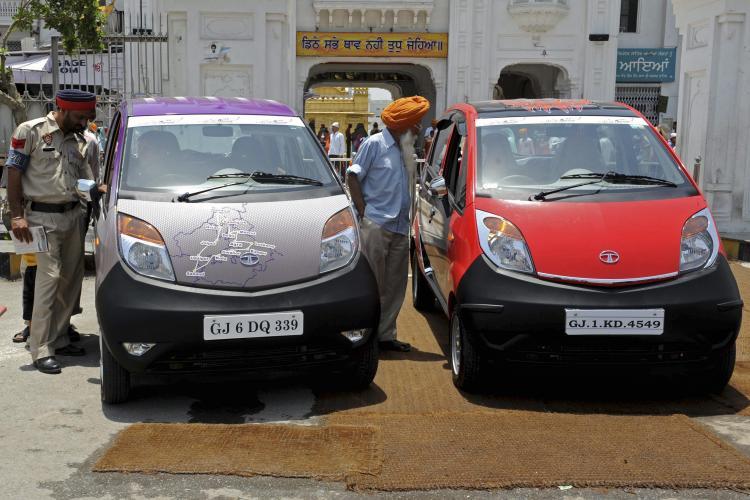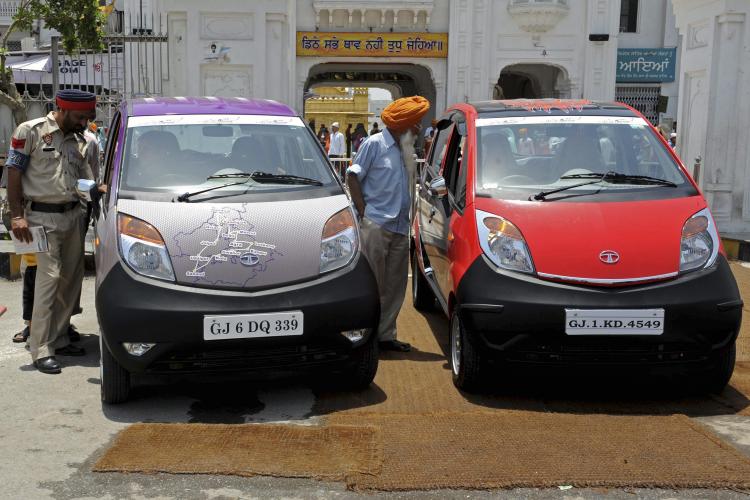At the time, 20 Indian banks stood in line to finance the Tata Nano, including Tata Motors Finance Ltd., charging the highest interest rate (13.4 percent to 14.5 percent), with the other 19 banks charging between 9 percent and 11.75 percent interest.
The media hype created a Nano car frenzy, which generated more than 40 million website hits by April 8, 2009, and crashed the company’s website.
“A crash is not good news for any automobile company, but this one—a barometer of the heightened interest in the Nano among Indian consumers—evidently was,” according to a Knowledge@Wharton (KW) article at the time.
Nano Sales Hype Short-Lived
Tata Motors had told the media that it predicted up to 20,000 Nano sales a month by the end of 2010.
In June 2009, Tata Motors announced that it had chosen “the first 100,000 owners of the Tata Nano from among the 206,703 final list of applicants who had booked the car,” with the owners receiving the car between July 2009 and the end of 2010.
Tata couldn’t deliver the car due to production problems, so a computerized program selected 100,000 customers from the 206,703 who had already paid for the car, while about one-half of the remainder opted to wait for the car to be produced, and the rest asked for their money back.
Sales efforts continued and starting with July 2009, monthly sales started at 2,475 vehicles and reached 3,610 vehicles in December 2010. In real numbers, the Nano sales were only a small proportion of Tata’s monthly car sales. In December 2010, it was 6.99 percent of a total of 51,627 car sales.
Between July 2009 and the end of 2010, around 72,000 Nano cars were sold, according to the Indian media. It is not clear if the media included the cars that were bought before July 2009 and the total figure is 72,000, or if the 206,703 number in Tata Motor’s press release is no more than creating a buying hype.
“Ravindra Bhagat, an Ahmedabad-based businessman, was one such customer who bought a Nano last year. Bhagat’s dream turned sour when the car caught fire within 20 days of its delivery,” according to a December 2010 article in the India Economic Times.
Sales of the Nano hovered between 3,550 and 4,000 cars a month until May 2010, when the car sales more than doubled to 7,704 cars in June and 9,000 in July 2010. By August, the Nano car buying hysteria was over, with the numbers declining monthly until November, when Nano car sales were down to 509 cars for that month.
In October, a slight increase in the Nano car price of around $200 could have been responsible for the slump in sales. A $200 increase doesn’t sound like much in America, but in India, where earnings are lower than in the United States, such an increase was not taken lightly.
In December 2010, sales again reached 5,784 and by the end of March 2011, Nano sales were at 8,707, approximately 10 percent of the company’s total car sales.
Experts suggest that car safety, lack of low interest loans, absence of a well-designed marketing campaign, and marketing channels that would bring the car to the poorer segment of India’s society, such as India’s large-sized bazaars, are the main reasons that Tata sales did not reach the predicted 20,000 monthly sales figures.
“According to Gautam Sen, editor of Auto India, the real problem behind the declining sales is ‘a total marketing failure,’” KW said in its January article.
“There has been a sense of overconfidence and arrogance on the part of the company. They thought the car would sell itself because it was ‘the Nano’ and [because of] the kind of coverage it received around the world. They just took their eyes off the ball,” Sen said.
Next: Luring Consumers to Buy Nano
Luring Consumers to Buy Nano
In January, Tata was offering to those working in the defense sector an improved maintenance package that would also cover normal wear and tear, excluding tires and batteries, for four years or up to 60,000 kilometers (approximately 37,282 miles) if the Nano was purchased during February, which was a one-month window.
After the dismal November 2010 sales, Tata Motors Finance announced “a special Tata Nano finance scheme, under which a customer can get a loan with select documents in just 48 hours,” including some other goodies, such as a comprehensive maintenance package for a little more than 2 cents a month.
Tata Motors also announced the opening of sales offices throughout the country.
“Now in an effort to boost sales, Tata Nano will openly sell across its 874 sales branches in India,” according to a January 2011 entry on the Marketing91.com website.
Collecting Awards
The Tata Nano received in December 2010 the prestigious Indian Car of the Year (ICOTY) award.
Also in December 2010, the Chicago Athenaeum: Museum of Architecture and Design and the European Centre for Architecture Art Design and Urban Studies awarded the Nano the GOOD DESIGN Award 2010 Transportation with 14 other awardees, including Mercedes Benz Design for Daimler AG, BMW, Kia Motors, and Volkswagen AG.
In May 2010, the Tata Nano received the 2010 Edison Green Award Gold prize under the Best New Product Segment for Transportation.
Academia Passing Judgment
“Those who start with lot of buzz have to deal with the aftermath of disappointed consumers. Those who have a quieter launch are better equipped to alter the product and the plan as they go along, away from the glare of the media,” said Sudipt Roy, professor at an Indian business school, in the KW article.
The Nano had some mechanical problems, but Tata Motors didn’t recall the car for repair, as it generally is done by Western car manufacturers. Instead, Tata claimed that the car needed some added features to adapt it to the rougher terrain, although the car had been sold mainly to those who owned several cars and not to those living in the boondocks.
“There was a great disconnect in the kind of people they were reaching out to and the kind of people they wanted to sell to,” Roy said.
The professors didn’t accept Tata’s explanation and suggested that India hasn’t reached the consumer protection standards that are recognized as normal in Western countries. Also, the initial buying frenzy was not really because of an attraction to the Nano, but because of the Indian psyche, which considers how much one could profit in the future.
“Indian consumers have a lottery mentality: People apply for things they don’t want, expecting to sell them at a premium when they get delivery,” the KW article suggested.
Assumptions abound, and industry experts are coming up with many reasons for the Nano’s false sales start. An interesting theory is that Tata Motors officials opened their mouths too early, without having done their homework.
The company predicted car sales without having the manufacturing plants ready and production ready to go. In India, to set up a manufacturing plant is wrought with political problems.
“The root of all [of Tata Motors’] problems is that they didn’t have the capacity right to go all over the country from day one. With such an initiative, the most important thing is to have the mother plant up and running,” said Abdul Majeed, a PricewaterhouseCoopers India employee, in the KW article.







Friends Read Free